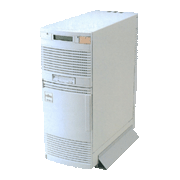Fujitsu announced the FMR-340SV in July 1992 as a dedicated PC server intended to be used as the hub of PC LANs,*1 which were in increasing demand because of the proliferation of PCs.
The Fujitsu FMR-340SV, unlike the previous FMR series models, featured a PC/AT compatible architecture*2 with EISA*3 bus support. This architecture was selected to ensure the FMR-340SV could support the multi-vendor environments and diverse application configurations required of servers.
Features of the FMR-340SV:
- (1)Used industry standards
- Fujitsu used a PC/AT compatible architecture with EISA bus support as the server’s core architecture. This made it easier to source compatible hardware and increased support for the extended functions of the server’s network operating system (Microsoft’s Japanese version of OS/2 LAN Manager or Novell’s NetWare).
- (2)Improved performance
- To ensure the server had sufficient performance to respond to requests from multiple client PCs, Fujitsu made the following enhancements to the CPU, internal bus, and I/O performance:
- Intel i486SX (20 MHz) and Intel i486DX (33 MHz) high-speed CPUs
- 32-bit high-speed EISA bus
- Fujitsu developed EISA-compatible high-speed I/O cards, such as LAN cards, SCSI cards,*4 and cards to communicate with Fujitsu mainframes and office computers
- (3)Scalability
- To improve the server’s adaptability to PC LAN environments, the use of which was expected to skyrocket, Fujitsu adopted a modular construction that separated each printed circuit board by function into main boards, CPU boards, memory boards, etc., so the server was field upgradeable.
- (4)Reliability
- The FMR-340SV came with disk mirroring, an uninterruptable power supply, and a lockable cabinet to prevent theft in order to meet the rigorous reliability demands of a PC LAN server.
- *1. PC LAN: A PC usage environment in which multiple PCs are connected via a LAN to share peripheral devices, such as hard disks and printers, and to share data functions efficiently so as to raise group productivity through coordinated operations.
*2. PC/AT: Abbreviation for IBM personal computers first sold in 1984. Because IBM released the key internal specifications of the PC/AT, it became a de facto industry standard for PCs for many years.
*3. EISA: Extended Industry Standard Architecture. A processor bus standard with enhanced performance over the IEEE’s Industry Standard Architecture (ISA) standard for PC/AT buses.
*4. SCSI: Small computer system interface. A set of standards for physically connecting and transferring data between computers and peripheral devices, such as magnetic disks.
| Model name | 20 | 30 |
|---|---|---|
| Introduced | July 1992 | |
| CPU | 486SX (20MHz) | 486DX (33MHz) |
| Main memory | 8MB− 64MB | |
| Internal disk (standard) | 170MB | 310MB,495MB |
| Internal disk (expanded) | Selectable:170 MB, 310 MB, 495 MB, 1 GB 4 slots | |
| LAN card | Selectable*: 10BASE5/10BASE2 or 10BASE5/10BASE-T | |
| OS | NetWare, OS/2 LAN Manager | |
| Other details |
|
|
*10BASE: transmission speed of 10 Mbps.
The specifications above were correct at the time the products were announced. Some specifications were later revised due to product upgrades.


